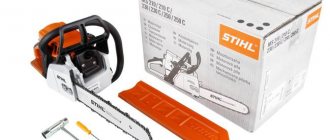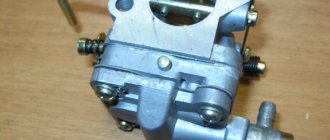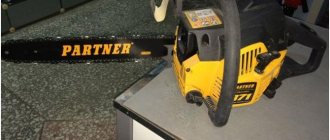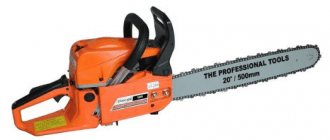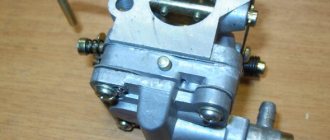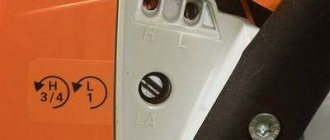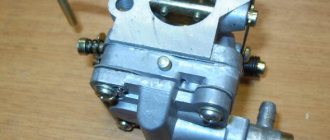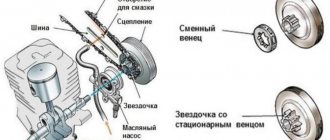Cleaning the carburetor of a chainsaw of any modification, configuration and power follows one traditional and correct scheme, and its need arises as a result of clogging of the part. To understand that it’s time to clean the carburetor, you can observe how the saw starts up and immediately stalls, perhaps still “puffing”, making sounds trying to get the desired speed. One way or another, cleaning the carb with your own hands is quite possible, because our specialists provided instructions and demonstrated a video on how to do it quickly and correctly. Regarding proper cleaning, here we are talking not only about the use of certain products and liquids, but also about the format of purging, putting the carburetor back together, and also checking its readiness for future work.
Sometimes spare parts for a chainsaw do not need repair and cleaning, but timely replacement. Therefore, while your carb can still be cleaned and returned to its original working condition, take the advice from KosiKos and let your mechanism be healthy!
How to clean the carburetor on a chainsaw with your own hands
Before cleaning the carburetor on a chainsaw , let's look at the situations when it needs to be cleaned:
- the saw does not start and stalls;
- the tool does not start;
- The tool stalls when you press the gas.
There are situations when cleaning the carburetor does not help, then you need to replace the repair kit; if after this procedure nothing has changed in the operation of the chainsaw - check the rubber adapter that is located between the cylinder and the carburetor (in its place there may be a rubber adapter with a brass insert). We remove the top cover, filter, long bolts, adapter, disconnect the tubes from the carb and remove it. Direct cleaning process:
- first you need to clean it with a fluffy brush from external dirt and dust so that it does not get inside during disassembly;
- we start with the “H” bolt, which is responsible for the upper working position of the carburetor at maximum speed. We twist it, counting and remembering the number of revolutions, for example, 2.5. Next we unscrew it
- screw in screw “L” while counting the revolutions; it is responsible for low speeds. For example, 4.5 revolutions. We record the indicators and unscrew it;
- remove the top and bottom covers using a screwdriver, unscrewing the bolts. It is better to do this not in a canopy, but on a hard, non-slip surface;
- take out the needle;
- if the gaskets and membranes are very worn out, worn out, they also need to be replaced with new ones, and you can order a carburetor repair kit for Husqvarna, Leader, Shtil or Partner saws in the KosiKosa store;
- often before cleaning you can observe the following picture - in the “sump” and other containers there is a lot of dust and debris;
- We clean the carb by first soaking it in its solvent, then blow it with compressed air using a compressor. We repeat the procedure 2 times. We clean the membranes separately and put them back together. First we put the needle in place;
- We mount the rocker support back onto the needle;
- depress the spring and squeeze out the fixing bolt;
- put the membrane and bottom cover in place and tighten it with bolts (you need to remember or sign which ones secured it);
- We also put the upper membrane with the lid in place and tighten it with bolts;
- place screw “L” all the way, and then unscrew it 4.5 turns, (as an example) as it was on the carburetor, and screw “H” also screw in until it stops and unscrew it the same 2.5 turns (as an example ), maintaining the previous settings. This is necessary in order not to lose settings;
- we return the carburetor to its place in the chainsaw for checking, putting it on the throttle valve;
- the hose coming out of the cylinder is hung on the top, the hose coming out of the tank is on the right side of the carburetor, and the hose that goes for pumping from the primer is on the left - we connect all the hoses to the carburetor;
- insert 2 bolts into the adapter and put it in place;
- close the flap, press the primer several times (10 is enough);
- We are trying to start the instrument.
As you can see, cleaning the carburetor of your tool with your own hands is not at all difficult if you follow the instructions, chronology, fix the maximum and minimum screw speeds, and assemble the unit in exactly the opposite order. The KosiKosa petrol tool store also demonstrates a high-quality video, where all the instructions are clearly supported by a clear example.
Who can repair carburetors?
Everything said below applies to any models of chainsaws, including gas trimmers, scythes and other equipment. Adjusted, of course, for design features.
There is an opinion that it is better not to climb inside a chainsaw yourself. For those who are used to working with a hammer and sledgehammer, this may be true. Otherwise, any more or less neat person whose hands do not shake can fix any problem with his work. In general, this is a job available to anyone.
Of course, it happens that the problem cannot be solved on its own. And you need to contact the service center. But firstly, 90% of malfunctions are usually solved by simply flushing the jets or, in the worst case, replacing the membranes or adjusting the needle, and secondly, in the worst case, even if you are desperate, the carburetor removed from the saw can be easily replaced. The new original one is, of course, a little expensive. The price for an analogue made in China is 700-800 rubles, you can buy it in a well-known store or from Russian dealers. In general, there is nothing to lose - let's get into the carburetor!
Carburetor cleaning and everything about it: useful tips
cleaning a chainsaw carburetor is . We have described all the nuances and little things, and now in the summary we will consider other options for breakdown or malfunction of the tool that accompany carb clogging, which also need to be paid attention to:
- failure of the rubber adapter. When it breaks through, the chainsaw shows the same non-working symptoms as with a clogged carburetor. It is located between the cylinder and the carb;
- you can also hear its name as a pipe. In addition to the fact that the carburetor in the saw is clogged, the pipe may rot;
- Cleaning the carb will not be enough; you will have to change the rubber adapter. Our catalog will help you do this easily;
- the fuel filter retainer may be cracked or broken, accordingly, all dirt enters the carburetor;
- the mesh on the crab, which is supposed to clean the gasoline that passes from the tank to the needle, may be clogged;
- do not forget to record the number of revolutions by which the screws “H” and “L” were unscrewed. By correctly returning them to their place, you will save the carburetor settings, but this is a completely different article...
Advantages and disadvantages
Zama carburetors are very reliable and easy to use. Specifically, the Shtil 180 chainsaw has a carburetor, which does not have screws for adjusting the quality and quantity of the mixture, as we are used to. One screw makes adjustment much easier.
A diaphragm carburetor has no significant disadvantages. With such a carburetor, the chainsaw works in any position. For side cutting, vertical cutting, etc.
Despite the above-mentioned advantages, the carburetor is sensitive to fuel quality. In addition to clean air from the air filter, purified fuel from the gas tank must be supplied to the carburetor. But this is not always possible, so at least once every six months it needs to be cleaned and blown out.
Chainsaw carburetor design
The carburetor of any new chainsaw is an integral part of the engine, which continuously regulates the amount of air required for constant mixing with fuel and supplies the finished mixture to the internal combustion engine cylinder.
In most modern chainsaws, built-in carburetors initially have a similar design and almost the same principle of operation. There are certain differences only in the fuel units of Chinese models.
The main elements of the carburetors of all chainsaws include:
- float chamber - a small compartment whose main task is to maintain the optimal amount of fuel filled;
- atomizer is an important mechanism that is initially responsible for injecting fuel into the intake air flow;
- diffuser - located next to the standard inlet through which air enters the engine compartment of the chainsaw. The main function of the diffuser is to forcefully accelerate the suction of air masses;
- tube - required to supply air in small volumes - portions, the sizes of which depend on the needs of the fuel system.
The operating principle of a chainsaw carburetor is also quite simple.
When the chainsaw is running, the engine throttle valve is activated, which, when open, allows air to flow through the factory rubber tube. With the gradual opening of the standard valve and the tube connected to it, the float located in the chamber with fuel is activated. Continuously passing through a standard diffuser, the air intensively mixes with fuel. After this, the used ready-made air-fuel mixture is sprayed through the factory intake channel into the working cylinder of the standard engine. When spraying fuel, the pressure inside the float chamber of the chainsaw is almost identical to atmospheric pressure. At the same time, the pressure in the factory air tube is rarefied. Due to the difference in these indicators, air is continuously sucked into the tube. As engine speed increases, it requires more fuel. Accordingly, the tube should suck in more air. Thus, the ability of the engine to intensively gain speed required for sawing large wood largely depends on the carburetor.
Clean properly
To clean the chainsaw cleanly, you need the following tools:
- Phillips and flat head screwdriver,
- wrenches with heads of different sizes,
- special cleaning composition, cleaning cloth,
- Ultrasonic cleaner.
In the photo you can see a set of tools.
To clean carburetor chainsaws is to create the following algorithm:
- First you need to drain the fuel tank. Remove the chainsaw cover by unscrewing the fasteners. We remove the filter and disassemble the housing, removing nuts and clamps if necessary.
- Remove the fuel supply hose from its clamp, unscrew the fasteners of the carburetor top cover. Then remove the top cover and the blue gasket - the fuel pump diaphragm. There are spring clips to the left of the case, remove them and then the screws. It is advisable to label the parts and schematically record the places from which they were removed so as not to confuse anything during assembly.
- Remove the bottom carburetor cover, unscrew the screw and remove the needle valve and the spring underneath it. Then we remove the air damper and its axis using longitudinal force.
- Remove the throttle valve, control lever and throttle shaft.
- All removed parts of the carburetor are laid out on a flat surface, and we check the integrity. Highly worn parts must be replaced with new ones.
- Using a special cleaner, rinse the parts and dry them with a lint-free cloth. The pipes must be blown under pressure using a pump.
- For maximum effect, clean the carburetor with a chainsaw. Calmness can be achieved using a special bath cleaner that relies on the cavitation effect. The bath is filled with diesel fuel, the carburetor parts are immersed in it for several minutes. Finally, dry the parts with a pump.
chainsaw partner
350S
Carburetor
Walbro Website Maintenance. VKontakte community.
Don't start chainsaw partner
.
carburetor
for 7 bucks, shortcomings, how to fix them.
A detailed video with the cleaning process will help you do the job correctly.
After all the products are dried, you need to assemble the carburetor
. Usually the detergent evaporates completely overnight. It is better to wait one day after cleaning, as the remaining detergent on the parts may enter the fuel compartment, and when burned, they will release toxic gases.
Another important nuance associated with dismantling the chainsaw is that it is necessary to accurately install and adjust the needle valve blade, otherwise the chainsaw may not start. To check if the petal is installed correctly, you can use a blade. By placing it on top, we will see how freely the petal rotates. If there are no problems, then everything is in order - you can continue the assembly. If the stroke problem does not occur, then the petal should either be pinned or the edge on it bent.
How to properly adjust the carburetor on a chainsaw?
In order for self-adjustment of a chainsaw carburetor to bring the desired result, you need to carry out preparatory work. First of all, the operator must ensure that the engine is in good working order. To do this, be sure to remove the top cover of the protective plastic case and carefully inspect the engine cylinder-piston group for burrs, cracks and other defects. If they have formed, the surface of the assembly will need to be sanded. It is important not to damage the protective chrome or nickasil coating of the cylinder.
Next you need to inspect the spark plug. If a thick layer of dried carbon deposits forms on it, the part will need to be unscrewed and thoroughly cleaned. To do this, you need to heat the candle and carefully scrape off any remaining dried oil from its tip.
At the end, you will need to inspect the parts of the entire fuel system of the chainsaw. Clogging in the pipes, accumulated debris in the fuel and air filters, unstable operation of the diffuser - all this leads to the engine losing the required speed. As a result, the operator does not receive accurate information about the operation of the motor and cannot set the correct settings. To prevent this, you need to wash the carburetor parts, filter and tube. After they are completely dry, they can be installed in their original place.
Checking the ignition system
Chainsaw ignition system
If the tool does not start, the problem may lie in the trigger mechanism or ignition system. If the starting device is working normally, then it is necessary to carefully inspect the spark plug. It needs to be unscrewed and carefully inspected.
Particular attention here should be paid to the electrodes, on which plaque may accumulate. If there is a red-brown coating on the electrodes, this indicates serious malfunctions of the entire starting system
So, the cause of the malfunction may lie in the carburetor.
If the ignition system works normally, but the tool does not work correctly, then the problem may be due to an excess of air-fuel mixture. Here you need to adjust the carburetor and clean the jets.
Do-it-yourself chainsaw carburetor adjustment
If during the inspection, carbon deposits were found on the spark plug, this means that the tool runs on low-quality gasoline. This may also be due to improper functioning of the carburetor.
To solve this problem you need to do the following:
remove the carburetor and check it; if necessary, clean and adjust it; replace fuel; install the carburetor and check the tool in operation.
It is worth noting here that the carburetor is a rather complex unit. Therefore, if there is a need to repair it, it is better to seek help from specialists.
Attention: the chainsaw should only operate on the fuel specified in the instructions. Using low-quality fuel will lead to various malfunctions
With this information, you can repair the Shtil 180 chainsaw at home. Of course, you need to take into account that it is better to fix more serious faults in service centers.
Watch an overview video about diagnosing the lubrication system of the Stihl MS180 chainsaw:
Trimmers and chainsaws
1) Malfunctions of the STIHL MS 180 chainsaw: Gas wedges and, finally, the gas key stops moving completely. Cause: Clear translucent resin on the carburetor throttle shaft, causing the throttle to seize. Resin is formed when gasoline dissolves the defective choke coating. Chainsaw repair: The carburetor throttle body axis should be cleaned with acetone, and the air damper itself should be irradiated with tin.
2) Chainsaw malfunction: The chainsaw “does not pull.” Cause: Clogged carburetor. Chainsaw Repair: Cleaning and Cleaning Carburetor Chains
Particular attention is paid to cleaning the carburetor should be cleaned with an additional filter (grids in the carburetor chainsaw) - remove the largest carburetor cap, remove the membrane under it and clean the dirt from the mesh in the groove (careful not to lose this mesh). Of course - clean with thin copper wire, rinse and blow out all the channels in the carburetor chainsaw
3) Malfunction of the Calm 180 chainsaw: The idle speed of the chainsaw has increased (the idle speed adjustment is ineffective and unstable). Cause of malfunction: Air intake through the crankshaft oil seals or elsewhere. Chainsaw repair: Replace the crankshaft oil seals and check for other possible suction areas.
Read:
4) Chainsaw malfunction: After disassembling the carburetor, the chainsaw is difficult to start, white smoke appears from the chimney. Reason: When disassembling the carburetor, the spring is lost under the needle lever, as a result, the needle does not block the fuel supply, and the spark plug is “filled” with gasoline. Chainsaw Repair: Locate and place the spring under the needle lever in the chainsaw carburetor.
5) Chainsaw malfunction: The chainsaw does not start well, it does not work well. reason: the gasoline spark plug is “pouring” due to the sticking of the needle in the carburetor or a high-lifted rocker. Do-it-yourself chainsaw repair: Wash and bleed the carburetor, install the rocker correctly.
Read also: What is heat treatment of parts
Do-it-yourself chainsaw carburetor adjustment
To independently adjust a standard carburetor, the chainsaw owner will need a Phillips or flathead screwdriver, as well as a manual tachometer.
To adjust the carburetor of a chainsaw, spring-loaded adjusting screws are provided in the basic structure of the carburetor.
Depending on the brand of chain saw, the markings of its adjustment screws may vary. However, in order to initially correctly configure the carburetor on a chainsaw, you can always follow the same algorithm:
- First, the operator must look in the saw's instruction manual for the exact incremental angles for turning the spring-loaded adjustment screws. Immediately after this, on the saw in use with the engine turned off, they must be turned according to the instructions in the manual. Failure to do this may result in the operator breaking the tool's motor;
- Next, the chainsaw used on the farm will need to be placed motionless on a flat, stable surface. In this case, the bar and factory chain must initially be directed away from the operator;
- Then you need to start the internal combustion engine of the saw and give it at least 10 minutes to warm up;
- After this, you need to find the correct position of the screw L. To do this, the operator must slowly turn it along and counterclockwise until the motor runs quietly and without failures;
- If as a result of this the chain begins to rotate, then it is necessary to find the position of the screw T at which the chain will stop in place:
- Next, you will need to connect a tachometer to the internal combustion engine cylinder. Then you need to start turning screw H. As soon as the readings on the tachometer match the instructions in the saw instructions, the screw can be released.
When flushing the carburetor is no longer worthwhile
Flushing the carburetor with your own hands is the easiest way to restore the functionality of the device. However, it does not always allow you to fix various types of breakdowns. To make sure that the device really needs cleaning, and washing will help restore the functionality of the mechanism, you will need to disassemble it.
If after disassembly some factors are discovered in the form of corrosive deposits (oxidation of aluminum), as well as the formation of warping in the carburetor channels, then ordinary washing will not help here. You can use the washing procedure in a special ultrasonic bath, but even in this case the chances of restoring functionality do not exceed 50%-60%.
Drawing a conclusion, it should be noted that the need and possibility of cleaning the carburetor can only be assessed after disassembling it. Here it should immediately be noted that the carburetor cleaning procedure can be performed in two ways:
- Automatic - washing is carried out in a special ultrasonic bath. Features of the procedure are discussed below.
- Manual - this method is not always suitable, but involves cleaning the channels of the mechanism using a special carburetor cleaner. This method is only suitable in cases where there is no deformation of the carburetor channels. If the process of corrosion or warping has begun in the channels, then, depending on the complexity of the process, only washing in an ultrasonic bath can help, but not always
Buying an ultrasonic bath specifically for cleaning a chainsaw carburetor is simply irrational. That is why in this material we will consider the manual washing procedure. We will also learn from this material what cleaning with an ultrasonic bath is.
This is interesting!
Regularly blowing out the carburetor with a compressor will not do anything, so don’t console yourself with the thought that now I’m blowing out the channels and the chainsaw will work like new.
How to flush a chainsaw carburetor?
You should think about cleaning the fuel unit of a power tool in the following cases:
- when it is difficult to start the engine;
- in case of unstable operation of the internal combustion engine at short-term idle speed;
- in case of failures when smoothly pressing the standard throttle trigger;
- with a significant increase in fuel consumption.
Most often, liquids that are found in almost every garage are used to flush the built-in carburetor of a chainsaw:
- kerosene;
- diesel fuel;
- pure gasoline;
- solvent.
Modern gardeners using powerful professional saws use more effective and gentle means:
- Mannol Vergaser Reiniger is a cleaner marketed in aerosol form. It quickly and easily breaks down even the oldest formations of resins, soot, oily deposits and other types of contaminants;
- Hi-Gear – This cleaner is distinguished by its high dissolution properties. It can remove old dried stains, oily crusts and the first signs of rust without harming the parts of the fuel system;
- Jet 100 Ultra is a high-tech spray designed to quickly clean the carburetor of a chainsaw. Shows a high rate of dissolution of the oldest oil stains.
Cleaning the carburetor on a chainsaw is performed in the following sequence:
- First you need to clean the outer part of the saw engine, and also remove and thoroughly rinse the factory air filter housing;
- Next, you can proceed to disassembling the power tool. To do this, you need to remove the filter housing and also unscrew the fasteners holding the carburetor together with the engine;
- Then you will need to carefully disconnect the thrust and gas cables from the carburetor. The springs included in the design must be removed so as not to stretch them;
- After this, you need to carefully pull off the fuel supply hoses from the factory fittings of the fuel unit;
- To clean the carburetor on a chainsaw, you need to remove it from the original mounting pins. At the same time, it is important to maintain the integrity of the gasket installed between the internal combustion engine cylinder and the fuel unit;
- The next step is to clean the outer walls of the carburetor. To do this, they can be treated with liquid cleaner or gasoline. In this case, you need to try to prevent dust and debris from getting inside the engine assembly or cylinder;
- Next, you will need to unscrew the screws securing the carburetor diaphragm, remove its cover and wash the internal cavity with an aerosol cleaner;
- After this, you need to dismantle the fuel pre-fine filter, and also disassemble the part of the assembly to which the fuel is supplied. All internal parts of the carburetor must be thoroughly washed with an aerosol cleaner. If the first cleaning does not bring results, then the washing should be repeated.
After all the internal parts of the standard carburetor have completely dried, you need to assemble the fuel unit in the reverse order and install it in place in the structure of the household chainsaw.
Related Posts
How to completely clean a chainsaw: carburetor, filter, muffler
When operating a tool such as a chainsaw, its owner often faces a number of problems, one of which is a clogged carburetor. How to clean a chainsaw filter - youtube. This can happen if the chainsaw is filled with low-quality gasoline or foreign debris gets into the fuel tank. Like another tool, a chainsaw carburetor. Husqvarna 137 chainsaw repair. In order to clean the carburetor of a chainsaw, you must first disassemble it.
Gasoline does not enter the chainsaw carburetor - repair methods
Most often, the standard cause of this common breakdown is the formation of a blockage in the fuel foam filter or tubes responsible for the stable supply of fuel to the factory metal cylinder of the engine. Every third Chinese power tool regularly suffers from these blockages. This is due to the low quality of the built-in filters and tubes that come with inexpensive Chinese chainsaws.
Repairing a fault involves removing and washing contaminated parts.
To do this you need:
- Remove the cover of the plastic saw body;
- Clear the space underneath and begin dismantling the hoses and filters. The tubes are attached to the outlet fittings using clamps. To disconnect the hoses without damaging them, you need to loosen and remove the clamps. After this, the tubes will need to be blown out with compressed air and washed with clean gasoline;
- To dismantle the filter, you must first remove it from the factory housing. After this, the element will need to be placed in a container with clean gasoline. After a day, the filter can be removed and given time to dry;
- After washing, all parts must be carefully installed and secured in their original place in the carburetor.
This cleaning regimen will help thoroughly flush the most vulnerable elements of the fuel system without having to disassemble the entire carburetor.
Features of washing in an ultrasonic bath
If you are wondering how to flush a chainsaw carburetor without disassembling it, then there is only one answer - nothing. An ultrasonic bath is also useless in this case, since during the cleaning process it is necessary to ensure the free removal of contaminants from the channels. If the carburetor is not disassembled, then these contaminants simply will have nowhere to go, and the result of such cleaning will simply be useless.
Some owners of gas-powered tools are looking for various flushing fluids and additives to the fuel mixture, hoping for their effectiveness. All these preparations and concentrates are simply useless, and if you really want to perform highly effective carburetor cleaning, then you should use a special ultrasonic bath. Even if your neighbor has convinced you of the effectiveness of such concentrates, then imagine the picture when all the contaminants enter the cylinder. Naturally, this will not lead to anything good, and as a result. Soon you will need to disassemble and repair or replace the internal combustion engine.
Ultrasound channel cleaning is the most effective, but even taking this factor into account, it is not possible to talk about complete restoration. It all depends on the extent of the clogging of the mechanism.
In addition, you must thoroughly know how to perform this procedure correctly. In particular, it is necessary to calculate the rinsing time as well as the temperature. The principle of washing a chainsaw carburetor in an ultrasonic bath is as follows:
- Remove the carburetor from the chainsaw and disassemble it
- It is necessary to disassemble the carburetor in order to ensure deeper penetration of the cleaning fluid into the channels
- The container fits the carburetor, except for small parts and rubber membranes
- You need to pour a special Ultra Red liquid into the container, which mixes with water
- Turn on the installation for the appropriate period of time 10-15 minutes
After completing the procedure, you will need to blow out the channels with compressed air, but carefully. After this, evaluate the quality of the flushing, and only after that assemble the mechanism.
Why does a chainsaw shoot into the carburetor?
The main reason for this malfunction is an incorrectly set distance between the ignition elements of a gas-powered tool. Because of this, the fuel that enters the standard cylinder of the internal combustion engine does not have time to completely burn in it. The result is a sound similar to an explosion. To effectively solve the problem, you need to set the ignition of the gas-powered tool, following the instructions in the user manual.
Often, this type of chainsaw carburetor malfunction is the result of a fuel mixture that is lean or too rich in oxygen entering the cylinder. To eliminate the breakdown, you need to adjust the operation of the metal throttle valve and the standard jets of the fuel unit.
How to disassemble for cleaning and replacing the repair kit?
In order to clean, change gaskets or needle valve, the carburetor must be disassembled. To do this, you need to unscrew 4 screws on the compensator cover and one on the fuel pump.
Once you open the housing, you should be extremely careful, because if debris gets inside the carburetor, it will make it impossible to operate. The thickness of the channels in it is comparable to the thickness of a thread or even a human hair.
A video on repairing a Shtil 180 carburetor can be viewed below. In it, the master talks in detail about the problems and clearly demonstrates the entire repair process.
Calm 250 chainsaw malfunction (carburetor chainsaw malfunction):
Immediately after winding, the chainsaw runs at increased speed, and if you press the gas, instead of starting to accelerate, it “chokes” and even stops. Or it starts poorly, does not rev up, and does not stall (this chainsaw problem applies to other expensive chainsaws with an accelerator pump in the carburetor).
Cause of chainsaw failure: Wear of the rubber cuff on the accelerator pump piston in the carburetor (fuel accelerator). This leads to air being sucked in by the accelerating pump, and the main jet injects a lean fuel-air mixture (mixed with a small amount of gasoline) into the diffuser, and the chainsaw first operates at increased speeds, and then “throttles” and nods. This occurs after 2-3 years of use and usually occurs during the hot summer months.
When adjustment is needed
The carburetor must be adjusted:
- If the settings are lost due to loose screws or vibration, or when trying to adjust the device.
- If the housing cover is broken.
- To find out the reasons why the design does not work.
- When the engine does not turn on or runs with effort, and then immediately dies out.
- When a chainsaw shoots into the carburetor or “sneezes.”
- The chainsaw vibrates a lot.
- To check why there was excessive fuel consumption.
- When thick exhaust appears.
- If the device does not receive gasoline.
- When the spark plugs are blackened or coated.
- The saw cannot operate at high speeds and increase power.
- Check the engine if it turns off when revving up.
- The operation of the air purification units was disrupted.
- Debris has entered the mixture distribution system.
- The pistons have worn out.
Adjustments also need to be made when changing the brand of fuel and changes in humidity.
Carburetor chain malfunction
Remove the carburetor from the chainsaw. Remove the fuel pump cover using the diaphragm by unscrewing one screw in the center of the cover. Then turn the carburetor towards you using the throttle body, on the side where there are two holes, one pin is visible, there is an accelerator pump underneath it. Remove the retaining ring from the outside of the pin and disconnect the wire spring choke. Unscrew the screw in the center of the throttle body, remember how the throttle is installed (and then put it down) and remove the throttle. Pin hole (the accelerator is spring loaded and if you pull the throttle shaft out and don't close the hole the accelerator will pop up), then rotate the throttle shaft and remove it. Shake the accelerator (piston) out of the hole with a spring. There is a rubber seal (ring) on the piston. its wear is what causes the chainsaw to malfunction. rubber cuff and spring (they are sold as a repair kit). Or you can remove the worn piston with spring and plug the hole by hammering in a rubber plug (the chainsaw will be without an accelerating pump, i.e. it will not accelerate for 3 seconds, but for 4 seconds, but it will work well because it will not intake air carburetor).
Assembly after repairing a chainsaw malfunction (after removing a carburetor chainsaw malfunction) is performed in the reverse order of disassembly. When assembling the throttle body, before screwing in the screw, the throttle body must be properly positioned so that it does not stick, and screw the throttle body screw onto the axle, degrease and spread with a special thread sealant (sold in small pipes, red, liquid) or pliers because, If this bolt comes out during operation, it goes directly into the cylinder) and repair or replacement of the piston cannot be avoided). Therefore, we looked at troubleshooting this chainsaw problem.
Chainsaw Stihl 180 (stihl 180) oil supply and carburetor repair | Country affairs
The STIHL MS 180 chainsaw is an indispensable tool designed for harvesting wood and other construction work made of wood. It is one of the most recognized gardening devices that is equipped with multi-functional capabilities.
The weight of the tool is about 4 kg. The power reaches 1.5 kW, and the bus length is 35 cm.
Note that this model of saw came from a semi-professional device with electronic ignition and fairly fast chain tension. In addition, the STIHL MS 180 saw has 2 tanks, intended for gasoline and for an oil mixture.
One of the main features is reduced vibration.
This result is achieved thanks to 4 shock absorbers. It is no secret that high depreciation has a harmful effect on human health and Europe has been fighting it for a long time.
It should be noted that it is not advisable to disassemble this saw yourself without special instructions; in this case, it is better to entrust the device to specialists.
STIHL MS 180 oil supply repair
Owners of this model of tool should be prepared for the fact that they may encounter such an unpleasant moment as a leak of oil to lubricate the chain. Oil can leak out while working with the tool and even when it is just lying idle.
What is the reason for this phenomenon? The fact is that oil leaks due to leaks in the area where the hose from the oil tank and the pump connects.
Interesting! Another article about oil supply repair is here!
In order to solve the STIHL MS 180 problem associated with the oil supply, it is advisable to disassemble the device.
Solution to the problem:
Check the filter oil for damage, clean it (if you filled in waste oil)
In general, the main problem is due to bad oil.
It is not recommended to pour oil into a chainsaw that is not intended!
What kind of oil to fill for the Stihl 180 chainsaw (stihl 180)
- Don't spare money on original oil. Stihl HP 2-stroke oil costs a little more, but cleaning costs even more.
- You need to pour high-quality fuel into the fuel, you can use Mobil 1, and three-phase is suitable for lubrication; under no circumstances should you pour waste oil into it.
- Of the inexpensive options, mineral oil is 15-40, in winter 10-30.
You can use M8, for example, or M10.
Remember personal safety when working with a chainsaw.
Remember that the performance of the chainsaw is affected by the quality of the oil being poured. Poor quality oil can cause the tool to operate ineffectively and adversely affect its parts.
To ensure that the STIHL MS 180 oil pump delivers oil without difficulty, check and clean the pump periodically. Thus, the oil supply process will be normal.
Carburetor STIHL MS-180
The STIHL MS-180 carburetor is equipped with one idle speed adjustment screw. The full load jet is not adjustable, meaning it cannot be changed.
You need to know the basic rules for setting the idle speed:
1) check the air filter, if necessary, change it;
2) check the spark-proof grille, if necessary, change or clean it. You can then turn on the engine and then warm it up.
STIHL MS 180 carburetor repair
Repairing a STIHL MS 180 carburetor is a very difficult process. Note that during repairs there is practically no risk of sudden changes in the cylinder-piston group.
If the chainsaw does not start, then follow these steps:
1) open and close the gas tank cap;
2) it is advisable to remove the candle and then dry it;
3) ventilate the combustion chamber.
If after this there are no positive results, then it is better to check the condition of the air filter, the gasoline supply process and the functioning of the spark plug.
This problem is associated with a valve (slepun), which becomes clogged, and as a result a vacuum is formed. To eliminate this inconvenience, you need to clean the valve (slepun) with a needle.
Systematically check the filter; if the muffler is clogged, the device will not be able to deliver the power that is put into it.
If the chainsaw was purchased with a warranty (as a rule, there is no other option), immediately take it to the service center.
Thus, the STIHL MS 180 chainsaw is very easy to use, has good ergonomics and a number of significant advantages.
And also watch the video Disassembling the STIHL MS180 chainsaw
Source: https://dachnoe-delo.ru/benzopila-shtil-180-remont-podachi-masla/
Cleaning correctly
To properly clean your chainsaw, you will need the following tools:
- Phillips and flat screwdriver,
- wrenches with heads of different sizes,
- special cleaning composition, cleaning cloth,
- ultrasonic cleaner.
The set of tools can be seen in the photo.
Cleaning the carburetor of a chainsaw should be done according to the following algorithm:
- First you need to drain the remaining fuel from the fuel tank. Types of chainsaws, 3.3.1 how to remove and clean the muffler when the chain brake does not work. Remove the cover of the chainsaw by unscrewing the fasteners. We take out the filter and disassemble the housing, removing nuts and clamps if necessary.
- Remove the fuel mixture supply hose from its clamp, unscrew the fasteners of the carburetor top cover. Then remove the top cover and the blue gasket - this is the fuel pump membrane. To the left of the body there are spring clips, remove them, and then the screws. It is advisable to label the parts and schematically record the places from which they were removed, so as not to confuse anything during assembly.
- Remove the bottom carburetor cover, unscrew the screw and remove the needle valve and the spring under it. The question is: “I’m filling a spark plug on a Shtil 180 chainsaw, what should I do?” Then, using longitudinal force, remove the air damper and its axis.
- Remove the throttle valve, drive lever and throttle shaft.
- We lay out all the removed carburetor parts on a flat surface and inspect them to ensure integrity is maintained. Parts with a high degree of wear must be replaced with new ones.
- Using a specialized cleaning agent, wash the parts and dry with a lint-free cloth. The tubes must be blown under pressure using a pump.
- To achieve maximum effect, you can clean the carburetor on a Shtil chainsaw using a special cleaning bath, the basis of which is the cavitation effect. The bath is filled with diesel fuel, and the carburetor parts are immersed in it for several minutes. How to adjust the carburetor on a chainsaw. Finally, we dry the parts using a pump.
How to repair a carburetor
on
a Shtil
ms 180 chainsaw.
repair cleaning stihl carburetor
180.
A detailed video with the cleaning process will help you do the job correctly.
After all the products have been dried, it is necessary to assemble the carburetor. Usually the detergent evaporates completely within a day. It is better to wait a day after cleaning, since residual detergents on the parts can get into the fuel compartment and release toxic gases during combustion.
Another important nuance associated with disassembling a chainsaw is that it is necessary to extremely accurately install and adjust the needle valve blade, otherwise the chainsaw may not start. You can use a blade to check that the petal is installed correctly. Having installed it on top, we see how freely the petal rotates. Adjusting the carburetor on a chainsaw: how to adjust the carburetor on a chainsaw. If no problems arise, then everything is in order and you can continue assembly. If movement problems still arise, then the petal must either be pressed down or the edge on it must be bent.
How to clean a chainsaw filter
The filter of your Husqvarna chainsaw must be cleaned after each use. The cleaning process itself depends on how the filter can be contaminated in two ways:
- Mechanical cleaning method, which is a purge filter.
- For higher degrees of contamination, the filter is washed in soapy water.
Important! Do not wash the filter in aggressive solutions: gasoline, diesel fuel, acetone.
